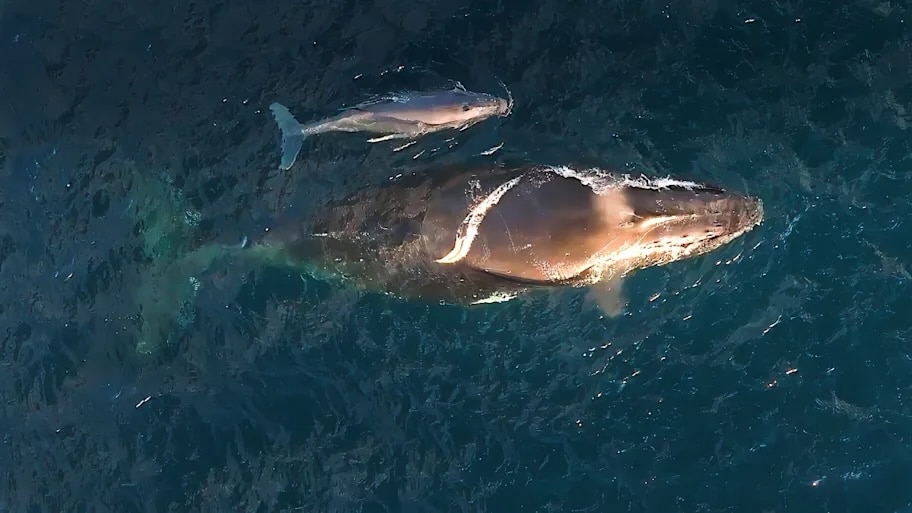This post was originally published on Eco Watch
Scientists once believed that humpback whales only gave birth in the warmth and safety of specific breeding grounds in tropical waters, where they spent half the year.
However, new research has revealed that humpbacks around Tasmania and New Zealand can birth calves much further south than expected, and can do so during their epic migrations.
“Historically the ‘feeding/breeding’ paradigm has dominated humpback whale ecology, where feeding and reproduction are spatially and temporally separated, with summer ‘feeding grounds’ and winter ‘breeding grounds’ restricted to habitats at the latitudinal extremes of their range,” the authors of the findings wrote. “In this paradigm, the summer and winter habitats are connected by a ‘migration corridor’ considered only to be a thoroughfare… However, humpback whales have been shown to feed in this migration corridor along with performing other important behaviors, such as resting, maintenance of skin health, and song sharing.”
One or two? How many can you see?
NEW whale research out today
I took this photo back in 2017 off the heads of Sydney Harbour.
McPhee-Frew et al. 2025
www.frontiersin.org/journals/mar…
— Dr Vanessa Pirotta (@drvanessapirotta.bsky.social) May 20, 2025 at 4:20 AM
Scientists say the results mean we must improve awareness of their expanded calving areas in order to protect baby whales.
“Hundreds of humpback calves were born well outside the established breeding grounds,” said Dr. Tracey Rogers, senior author of the findings and a marine ecologist at University of New South Wales, in a press release from Frontiers. “Giving birth along the ‘humpback highway’ means these vulnerable calves, who are not yet strong swimmers, are required to swim long distances much earlier in life than if they were born in the breeding grounds.”
The new discovery calls into question much of the scientific understanding of the lives of humpbacks. It had been thought that humpbacks spent summers feeding on krill in the polar and subpolar waters of places like Alaska, Iceland and Southern Greenland, then migrated south to warmer waters in the Caribbean, off the coast of Mexico and in the Hawaiian Islands.
“Alongside my studies, I work as a marine guide,” said lead author of the study Jane McPhee-Frew, a Ph.D. candidate in biological sciences at the University of New South Wales. “In July 2023, during a whale-watching tour, I encountered a mum and calf at the mouth of Newcastle Harbor — the busiest shipping port in Eastern Australia. The calf was tiny, obviously brand new. What were they doing there? But none of my tourism colleagues seemed surprised.”
Inspired by the sighting, researchers investigated the humpback whales’ calving range around New Zealand and Australia using citizen observations, reported strandings and government surveys. Data from migration surveys was supplied by New Zealand’s Department of Conservation Cook Strait Whale Project, and information on whale strandings as far back as 1991 was provided by Australian state wildlife departments.
The research team found records of humpback whale calves that included 11 births, 168 observations of calves and 41 strandings. Information on 118 whales’ direction of travel showed they continued to migrate north after giving birth.
“Humpback whale populations undertake extensive long-distance migrations from the Southern Ocean to breeding grounds in the tropics,” said co-author of the study Dr. Adelaide Dedden, a marine wildlife project officer with Australia’s National Parks and Wildlife Service. “They rely heavily on body reserves from an enormous amount of Antarctic krill to support the physiological costs of the journey and reproduction.”
The highest latitude where a humpback whale calf was detected was at Port Arthur, Tasmania — 932.1 miles further south than the researchers had previously thought humpbacks could calve.
The highest-latitude birth that was recorded was witnessed at Kaikoura, New Zealand, slightly further north.
A mother and baby whale swim at Kiama, New South Wales, Australia. Vanessa Risku – Instagram: droning_my_sorrows
Most observations of live humpback calves were recorded in 2016 and after, with two-thirds of them made in 2023 or 2024. Comparisons with whaling logbooks and historical texts indicated that calves born on the migration route had been observed before whaling decimated the population.
“I think it’s very likely that this pattern has always existed, but the low number of whales obscured it from view,” McPhee-Frew explained. “The Eastern Australia humpback population narrowly escaped extinction, but now there are 30, 40, or 50,000 in this population alone. It doesn’t happen overnight, but the recovery of humpback whales, and the return of their full range of behaviors and distribution, just goes to show that with good policies built on good science we can have excellent outcomes.”
The study, “Humpback whales (Megaptera novaeangliae) continue migration after giving birth in temperate waters in Australia and New Zealand,” was published in the journal Frontiers in Marine Science.
The post Humpback Whales Give Birth During Epic Migrations and Continue Traveling: Study appeared first on EcoWatch.





0 Comments